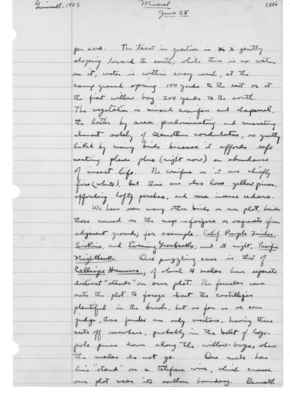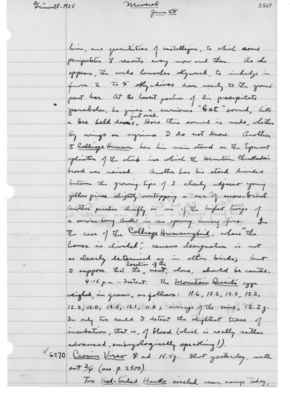Pages
S2 Page 50
Collector: Grinnell - 1925 Page Number: 2504 "pace" = 32 inches x = focus of interest of a pair of birds o = actual nest found
[drawing of 'areal census' mentioned on p. 2503]
| mq = Mountain Quail | wt = Western Tanager |
| wf = Wright Flycatcher | tw = Tolmie Warbler |
***legend of species found during areal census***
I paced off 200 paces to the west and 200 paces to the north, and completed the plot by placing stick monuments at the corners. It was then easy to find map locations of nests by appropriate pacings from the corners or side-lines. A pencil-drawn plot on brown paper, from which
S2 Page 51
Collector: Grinnell - 1925 Location: Mineral Date: June 28 Page Number: 2505
the above reduced plan has been accurately copied, has been carried with me in my note-book bag up to the present moment, and on it from time to time have been located positions of nest as found or of "centers of interest" (sometimes the "singing trees") of the birds whose nests we have not succeeded in finding. The close proximity of the tract studied to our camp has made it possible to devote many odd minutes to searching out nests; and in addition, of course, we have directed concentrated attention upon it for an hour at a time, again and again. Mrs. G. has been specially devoted to the problem, and more than half the actual nests located were found by her.
My "paces", averaged from a series of steps in a dusty place, were found to be 32 inches long. Therefore each side of our plot was 6400 inches long; 6400 x 6400 = 40,960,00 [sic] sq. in; divided by 144 = 284,444 sq. ft.; this divided by 43560 [= sq. ft. in one acre] = 6 1/2 acres, in the plot.
It will be seen that, in this 6 1/2 acres, there were 24 breeding pairs of birds, of 14 species - or not quite 4 pairs of birds to the acre. Undoubtedly, this is a maximum census figure for the whole region; while thousands of acres will equal this, other thousands of acres (above canadian zone, and very dry parts of Transition and Upper Sonoran) will average scarcely one pair
S2 Page 52
Collector: Grinnell - 1925 Location: Mineral Date: June 28 Page Number: 2506
per acre. The tract in question is gently sloping toward the south; while there is no water on it, water is within easy reach, at the camp ground spring 100 yards to the east or at the first willow bog 200 yards to the south. The vegetation is mixed conifer and chaparral, the later by area predominating and consisting almost solely of ceanothus cordulatus, so greatly like by many birds because it affords safe nesting places plus (right now) an abundance of insect life. The conifers on it are chiefly firs (white), but there are also lone yellow pines, affording lofty perches, and some incense cedars.
We have seen many other birds on our plot, besides those named on the map - foragers or vagrants from adjacent ground; for example, Calif. Purple Finches, Siskins, and Evening Grosbeaks; and at night, Pacific Nighthawks. One puzzling case is that of Calliope Hummers, of which 4 males have separate distinct "stands" on our plot. The females come onto the plot to forage about the castillejas plentiful in the brush, but as far as we can judge, these females are only visitors, having there [sic] nests off somewhere, probably in the belt of lodge pole pines down along the willow-bogs, where the males do not go. One male has his "stand" one telefone [sic] wire, which crosses our plot near its southern boundary. Beneath
S2 Page 53
Collector: Grinnell - 1925 Location: Mineral Date: June 28 Page Number: 2507
him, are quantities of castillejas, to which some peripatetic [female symbol] resorts every now and then. As she appears, the male launches skyward, to indulge in from 2 to 5 sky-dives down nearly to the ground past her. At the lowest portion of this precipitate parabola, he gives a curious "bzt" sound, like a bee held down, ^just once. How the sound is made, whether by wings or syrinx I do not know. Another [male symbol] Calliope Hummer has his main stand on the tipmost splinter of the stub in which the Mountain Chickadee's brood was raised. Another has his stand divided between the growing tips of 3 closely adjacent young yellow pines slightly overtopping a sea of snow-brush. Another perches chiefly on one of the highest twigs of a service-berry thicket in an opening among firs. In the case of the Calliope Hummingbird, where "the house is divided," census designation is not as clearly determined as in other birds; but I suppose that the ^location of the nest, alone, should be counted.
4:15 p.m. - Intent. The Mountain Quail's eggs weighed, in grams, as follows: 11.6, 12.2, 12.3, 13.2, 12.2, 12.0, 12.5, 12.1, 11.4; average of the nine, 12.2 g. In only two could I detect the slightest trace of incubation, that is, of blood (which is really rather advanced, embryonically speaking!).
6270 Cassin Vireo [female symbol] ad. 15.5 g. Shot yesterday, with set 2/4 (see p. 2500).
Two Red-Tailed Hawks circled near camp today,
S2 Page 54
*One egg rotten; three eggs incubated about 1/3; shells very thin. Note that these eggs are very thinly and finely speckled - not much more speckled than the abnormal (that is, speckled) eggs of wrighti!
**Eggs nearly hatched; broken shells saved in nest.




